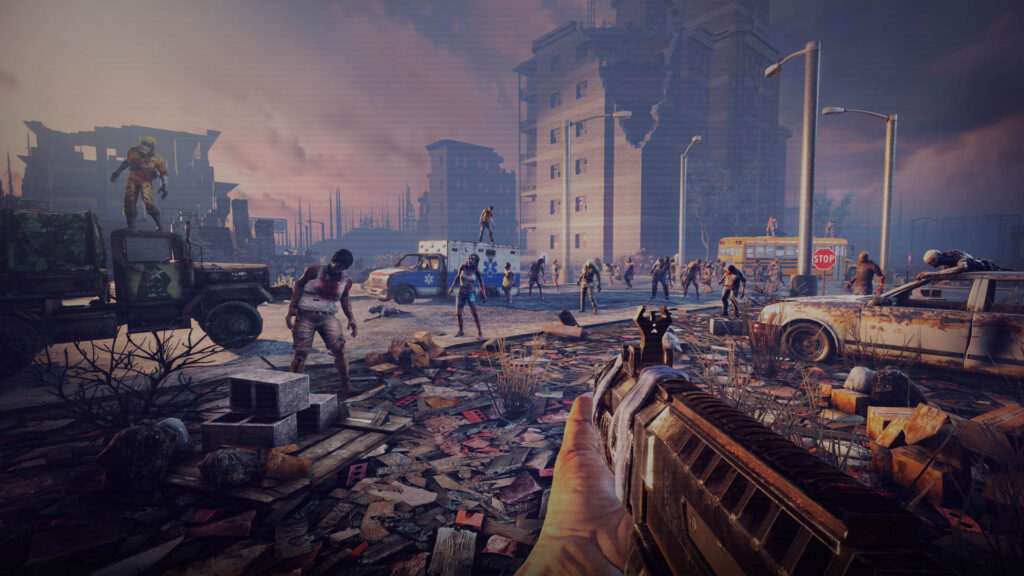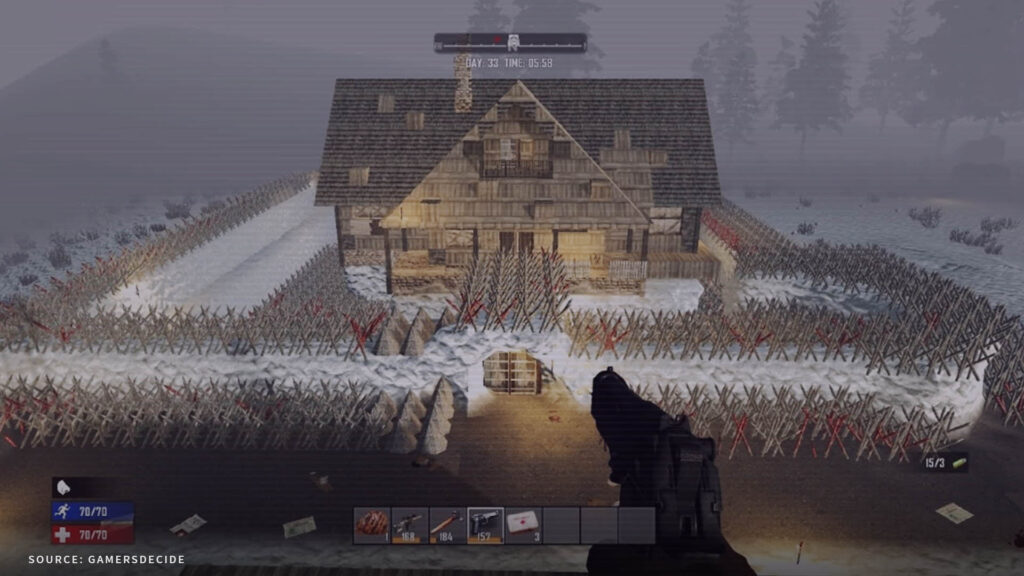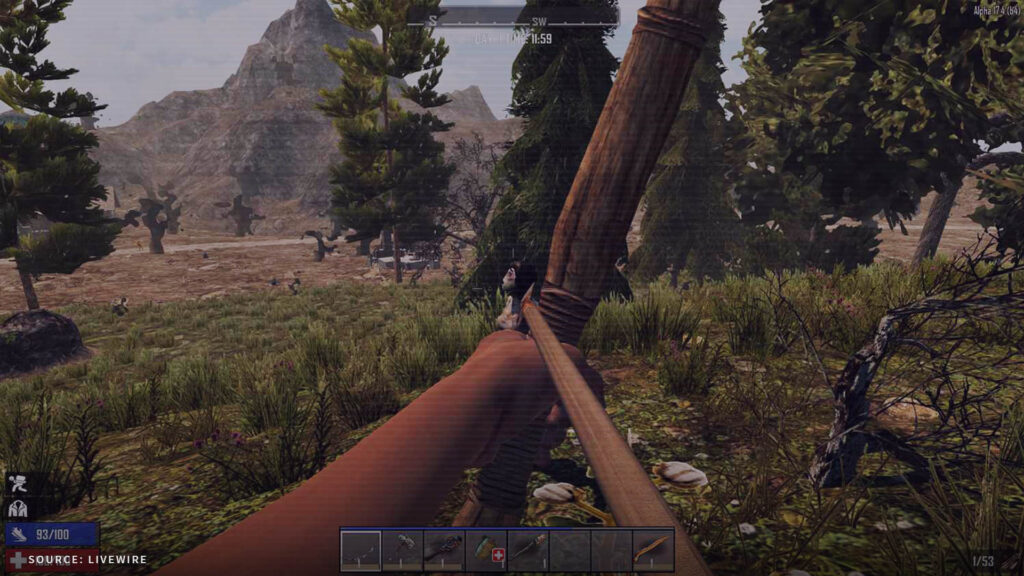The sun sets on a desolate wasteland. In the distance, unintelligible groans of undead grow ever louder, getting closer by the minute while you race against time, fortifying your shelter before the horde descends. This is the world of 7 Days to Die, where survival is measured in weekly intervals. Despite the all too familiar sounding introduction, this zombie game offers a unique twist on the apocalypse survival genre. Developed by The Fun Pimps, 7 Days to Die is a open-world survival horror game that has successfully entertained players since its Early Access release in 2013. Set in a post-apocalyptic world after World War III and overrun by zombies, it challenges players to scavenge, craft, build, and fight to stay alive.
What sets 7 Days to Die apart is its innovative fusion of genres: It seamlessly blends the resource gathering and world-building of Minecraft, the tense survival gameplay of DayZ, the strategic fortification elements of tower defense games, and the progression systems of RPGs. All of this is wrapped in a first-person shooter interface, creating a complex gaming experience. Reasons enough for us to take a closer look at how this unique mix survived among its many challengers in a crowded genre for over 12 years, still running strong.
7 Days to Die is the brainchild of The Fun Pimps, an independent game studio founded by brothers Richard and Robert Huenink and their friend Christian Lang. Established in 2012, the group of friends set out to create a game that would redefine the survival horror genre with its blend of genres into one cohesive experience. They see themselves in between indie and triple AAA but, at least at the beginnings, they were a very small studio with nothing more than a vision. After cobbling together their ambitious idea into a concept that would fit the launch of a Kickstarter campaign, they we’re met with an overwhelming interest from the gaming community. The initial goal of 200.000 US Dollars was quickly surpassed, eventually raising over $500,000 from nearly 13,000 backers, validating the developers’ vision.

On December 13, 2013, 7 Days to Die was released as an Early Access title on Steam. This early access launch allowed players to experience the game in its premature stages and provide valuable feedback to the developers. Nobody would have expected the Early Access to last for 12 years but, in hindsight, this model not only helped in collecting funds but was crucial in gathering valuable player feedback to refine gameplay mechanics, fix bugs, and add new features. Since its debut, 7 Days to Die has undergone continuous development, with The Fun Pimps committed to enhancing and expanding the game, releasing numerous updates that introduced new content and improved graphics. Major updates have included the addition of new biomes, advanced AI for zombies and wildlife, expanded crafting systems, and enhanced physics-based building mechanics.
One of the key factors in the game’s ongoing success is the developers’ dedication to community involvement. The Fun Pimps actively engage with the player base through forums, social media, and regular updates, listen to player feedback, address concerns, and implement suggestions. This creates a dynamic and responsive development process with an open line of communication to help build a loyal and passionate community. The game’s support for modding has further strengthened this bond. The Fun Pimps have encouraged a vibrant modding scene that adds new dimensions to the gameplay experience. Players have developed a wide range of modifications, from quality-of-life improvements to total conversion mods that drastically alter the game’s mechanics and aesthetics. Let’s briefly dive into what makes the gameplay experience stand out.
At its heart, 7 Days to Die offers a gripping core gameplay loop that keeps players engaged and on their toes, both, if you’re like me, figuratively and metaphorically speaking. The game centers around its three main activities: survival, crafting, and zombie defense. Starting with survival, players must navigate a post-apocalyptic world where resources are scarce and danger lurks around every corner. The scavenging hunt for food, water and medical supplies becomes imperative while also avoiding combating threats. A dynamic day-night cycle adds another layer of complexity, as zombies become more aggressive and numerous at night, forcing players to strategically plan ahead.

Crafting is the next fundamental aspect of the game, allowing survivors to create a wide range of items, from basic tools and weapons to complex structures and vehicles. Players collect raw materials like wood, stone, and metal, which they then use to craft necessities with recipes that cater to various playstyles and strategies. Base Building is the final cornerstone and essential for long-term survival. Players must construct shelters that can withstand the onslaught of zombie hordes, which involves designing defenses, setting traps and constantly upgrading structures to resist increasingly challenging waves of enemies. The game’s physics-based building system allows for creative and strategic construction, making base-building an engaging part of the overall experience.
As initially stated, 7 Days to Die stands out by effectively blending elements from various genres. The game draws heavily from survival horror traditions, akin to video games like Resident Evil and the popular show The Walking Dead. Zombies constantly threatening, limited resources, and the need for strategic planning, evoke a sense of tension and urgency, which are prominent traits of the survival horror genre. The game extensive crafting and building system draws heavy inspiration from Minecraft. Players can shape the world around them by gathering resources and crafting tools, weapons, and structures. This sandbox element provides a creative outlet, allowing players to experiment and personalize their approach to survival.
The procedurally generated world offers vast and diverse environments for players to explore, similar to games like The Elder Scrolls V: Skyrim and Fallout, tapping into the open-world genre of video games. Each new game generates a unique map filled with biomes, abandoned buildings, and hidden treasures, encouraging exploration and discovery. 7 Days to Die also includes RPG-like progression, where players can improve their skills and unlock new abilities. This system allows for customization and specialization, enabling players to tailor their character’s development to their preferred playstyle. Finally, the aspect of building and defending a base against waves of enemies brings in tower defense mechanics. Players must strategically place traps and fortifications to repel zombie attacks, adding a strategic layer to the survival experience. All these aforementioned elements combined create a multifaceted gameplay experience that appeals to fans of various genres.
As a standout title in the survival game genre, 7 Days to Die has influenced many subsequent games although this wasn’t its only impact. Its emphasis on survival mechanics, such as managing hunger, thirst, and health, has become a staple in the genre and the in-game day-night cycle, which affects zombie behavior, has been adopted by other survival games to add tension and strategy. Additionally, the game’s detailed crafting and building systems have set a high standard for player creativity and customization. The voxel-based world allows players to construct functional structures, a feature that has been emulated by other survival games aiming to offer similar levels of freedom and creativity.

When The Fun Pimps launched their game in early access on Steam in December 2013, they showcased a new way for indie developers to fund their projects and engage with their audience. The game’s success in early access proved that players were willing to invest in unfinished games, provided they saw potential and received regular updates and improvements. Games like Subnautica, ARK: Survival Evolved or non-survial games like indie-hit Hades have since utilized early access to great success, encouraging strong communities and refining their games based on player feedback. Beyond direct game influences, 7 Days to Die has also inspired broader trends in the industry. A growing popularity of genre-blending and the blurring of traditional genre lines can be seen in games that defy easy categorization like Oxygen Not Included or Scum.
Where does 7 Days to Die go from here? The 1.0 Release on July 25th brought back seasoned veterans as well as new blood, gaining 22.000 players, adding up to nearly 60k of average players. On its own, these numbers are far from a sorry state but they become even more impressive if you factor in the initial release date of 2013. The official roadmap gives an invigorating lookout into what’s still to come, especially the addition of a story mode alongside multiple overhauls, like a reworked weather system, which should further strengthen the game’s RPG-aspects.
The line between life and death is constantly shifting in 7 Days to Die and it only seems natural that the game itself equally shifts and changes, improving parts, revisiting older implementations and taking in all the feedback from the community. It’s a great role-model for other in-development games, to keep listening to players, actively encourage modding and just trying to be set on a vision yet always open for changes.

















